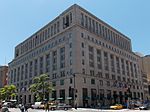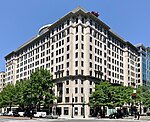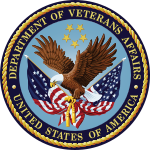Peyser Building—Security Savings and Commercial Bank
1928 establishments in Washington, D.C.Office buildings completed in 1928Office buildings on the National Register of Historic Places in Washington, D.C.Washington, D.C., Registered Historic Place stubs

The Peyser Building—Security Savings and Commercial Bank is an historic structure located in the Golden Triangle section of Downtown Washington, D.C. It was listed on both the District of Columbia Inventory of Historic Sites and on the National Register of Historic Places in 2012. The building was designed by architect George N. Ray and built between 1927–1928.
Excerpt from the Wikipedia article Peyser Building—Security Savings and Commercial Bank (License: CC BY-SA 3.0, Authors, Images).Peyser Building—Security Savings and Commercial Bank
15th Street Northwest Cycle Track, Washington
Geographical coordinates (GPS) Address Nearby Places Show on map
Geographical coordinates (GPS)
| Latitude | Longitude |
|---|---|
| N 38.902277777778 ° | E -77.035444444444 ° |
Address
15th Street Northwest Cycle Track 1500
20420 Washington
District of Columbia, United States
Open on Google Maps








